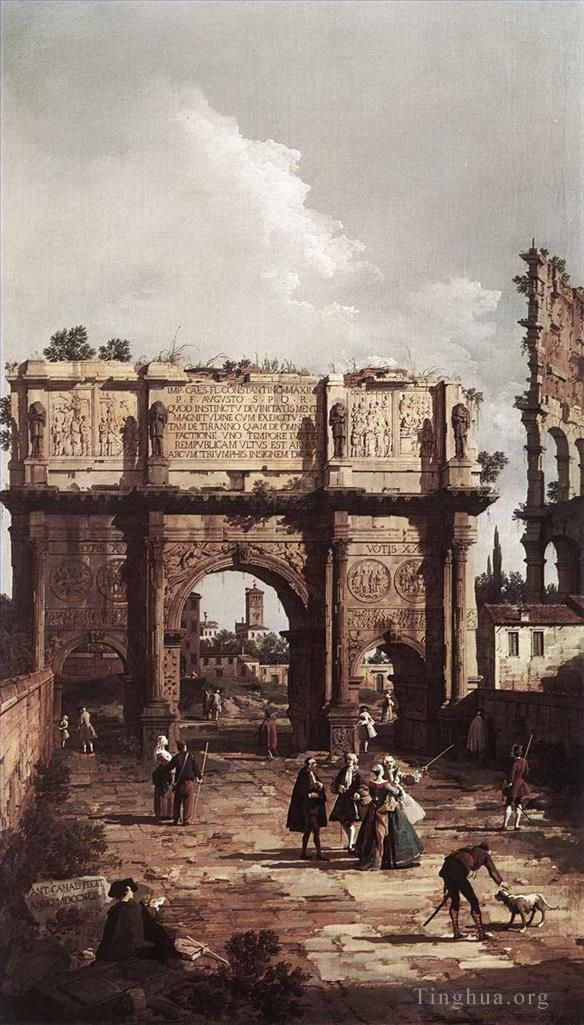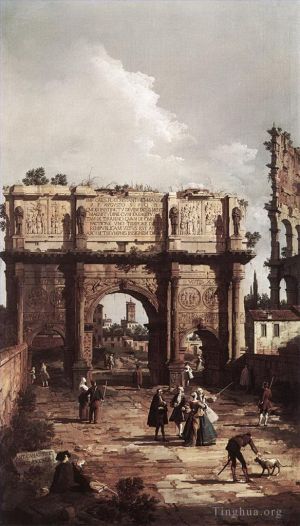Rome the arch of constantine 1742
Canaletto
- Price: Price on Request
- Art Type: Oil Painting
- Size:
- English Comments: 0
- International Comments: 0
- Creating Date:
- Introduction and Works of Canaletto >>
Work Overview
- Rome: The Arch of Constantine
Canaletto
Date: 1742; Rome, Italy *
Style: Rococo
Genre: veduta
Media: oil, canvas
Dimensions: 37.6 x 26.8 cm
Location: Royal Collection (Buckingham Palace), London, UK
This is one of a series of five impressive paintings of Roman subjects that Canaletto executed for Joseph Smith. It is not entirely clear whether they were based on a new visit to Rome, or sketches the artist had made there in 1720. It is possible that he could additionally have been inspired by prints of Roman subjects in Smith's collection.
The arch was built by the Emperor Constantine in the fourth century, to commemorate his victory over Maxentius. The view is playfully manipulated; the friezes and inscriptions he chose to depict are those which can be seen on the north side, but it is painted as though looked at from the south. Through it can be seen the church of San Pietro in Vincoli, and to the right the edge of the Colosseum. The main group of figures in the foreground, one of whom points with his stick, are probably Grand Tourists who have come to admire the ancient glories of the city.
The seated figure at the left, who has beside him a portfolio and ruler and is either writing or drawing, may well be intended as a self-portrait. This is particularly suggested by the figure's proximity to Canaletto's rather grand inscription asserting his authorship and the date of the painting, in a manner that replicates the carvings on the arch.
This painting is one of a unique group of five large upright views of Rome, depicting the major sights of the ancient city (RCIN 401002, RCIN 400700, RCIN 400713, RCIN 400524, RCIN 400714). Unusually for Canaletto, all the works are signed and dated prominently in the foreground. It is thought that the paintings formed a special commission for Canaletto's great friend and patron Joseph Smith, British Consul in Venice, who sold his outstanding group of paintings, prints and drawings to George III. Their tall narrow format suggests that the paintings were originally designed for a specific location, probably decorating a room within Smith's palace on the Grand Canal, however the cycle does not fall into an obvious arrangement. Acquired by George III in 1762, the paintings were hung in English frames in the Entrance Hall of Buckingham House, alongside the Venetian views.
The works are of high competence, yet are not entirely typical of Canaletto. While Canaletto did visit Rome around 1720, it is unlikely that he made a return journey in the 1740s. Therefore, it is generally supposed that this painting, and the rest of the cycle, is based upon drawings made by Canaletto's nephew, Bernardo Bellotto (1720-1780), who entered his studio in the mid-1730s and had been in Rome during the relevant period. This indebtedness to Bellotto explains the treatment of the figures, the tendency towards heavy shadows, and the less-convincing three-dimensionality of the pictures, atypical of the style of Canaletto.
This painting depicts The Arch of Constantine with various onlookers and other figures in the foreground. To the right of the arch is a portion of the Colosseum, and visible through the centre archway is S. Pietro in Vincoli, indicating that this view of the arch is from the south. An inscription is visible on the arch.
Signed on a stone extreme left foreground: ANT. CANAL FECIT / ANNO MDCCXLII
- Copyright Statement:
All the reproduction of any forms about this work unauthorized by Singing Palette including images, texts and so on will be deemed to be violating the Copyright Laws.
To cite this webpage, please link back here.
- >> English Comments
- >> Chinese Comments
- >> French Comments
- >> German Comments
- >>Report
- Capriccio with ruins and porta portello in padua
- The women s regaton the grand canal
- The campo di rialto
- The Eastern Facade Of Warwick Castle
- Riva degli Schiavoni west side
- The piazzetta towards san giorgio maggiore
- Doge Palace
- Santa Maria Zobenigo
- Grand Canal
- San Giacomo Di Rialto
- The Piazzetta
- Capriccio with classical ruins and buildings
- Grand Canal From Santa Maria Della Carita To The Bacino Di San Marco
- Basilica di vecenza and the ponte de rialto
- Capriccio of a round church with an elaborate gothic portico in a piazza a palladian piazza and 1755
- Piazza San Marco Venice (Piazza San Marco with the Basilica)
- The Nave of San Marco looking East (San Marco the Interior)
- Warwick castle
- The Bucintoro Returning To The Molo On Ascension Day
- A Regatta on the Grand Canal
- Venice Viewed from the San Giorgio Maggiore
- View of the Ducal Palace
- Piazza san marco looking east
- The Bacino di San Marco on Ascension Day
- View Of the Entrance To The Arsenal
- Dolo On The Brenta Venetian Venice
- The Molo Looking West
- Palazzo Ducale and the Piazza di San Marco
- Grand Canal The Rialto Bridge From The South
- Scala dei giganti 1765
- The Riva Degli Schiavoni
- Rio Dei Mendicanti
- The interior of henry vii chapel in westminster abbey
- View of the grand walk vauxhall gardens with the orchestra pavilion the organ house the turkish
- Perspective View with Portico
- Stonemasons Yard
- View of the Bacino di San Marco St Marks Basin
- Perspective with a portico 1765
- The thames with st pauls cathedral 1746
- Piazza San Marco 1730
- Reception Of The Ambassador In The Doges Palace
- Dolo on the brenta
- Return Of The Bucentoro To The Molo On Ascension Day
- The chapel of eton college 1747
- The Grand Canal From Rialto Toward The North
- The Grand Canal with the Rialto Bridge in the Background
- View Of Campo Santi Apostoli
- Perspective view with portico
- Capriccio of the grand canal with an imaginary rialto bridge and other buildings
- London Interior of the Rotunda at Ranelagh
- The Grand Canal looking East from Campo San Vio towards the Bacino
- The Fonteghetto Della Farina
- The Piazzetta towards S. Giorgio Maggiore
- The thames and the city of london from richmond house 1746
- Campo san rocco
- Night time celebration outside the church of san pietro di castello
- The Stonemasons Yard
- Canal Giovanni Antonio View Of The Grand Canal And Santa Maria Della Salute With Boats And Figure
- The Piazzetta towards Santa Maria della Salute
- Piazza San Marco The Clocktower
- Capriccio of a renaissance triumphal arch seen from the portico of a palace 1755
- Bacino di San Marco St Marks Basin
- San francesco della vigna church and campo
- Entrance To The Grand Canal Looking East
- Alnwick castle
- Piazza San Marco Looking Southeast
- Westminster abbey with a procession of knights of the bath 1749
- CANALETTO Grand Canal Looking Northeast From Palazo Balbi Toward The Rial to Bridge
- The Feast Day of St Roch
- Arrival of the French Ambassador in Venice
- CANALETTO Grand Canal Looking East From The Campo San Vio
- Capriccio Ruins And Classic Buildings
- The Entrance to the Grand Canal Venice
- A Regatta on the Grand Canal
- English Landscape Capriccio with a Column
- The dogana in Venice (Punta della Dogana in Venice)
- Santi Giovanni E Paolo And The Scuola Di San Marco 1726
- Campo santa maria formosa
- The Piazza San Marco in Venice
- San Cristoforo San Michele and Murano from the Fondamenta Nuove Venice
- The Grand Canal with Santa Maria della Salute looking East towards the Bacino
- Rome the arch of constantine 1742
- Santi Giovanni e Paolo and the Scuola de San Marco
- The Grand Canal near the Ponte di Rialto
- Venice Piazza San Marco and the Colonnade of the Procuratie Nuove









 Singing Palette
Singing Palette